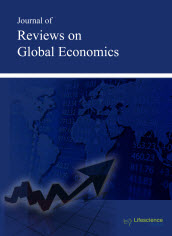jrge
Abstract - Yield Curve Forecasts and the Predictive Power of Macro Variables in a VAR Framework
|
|
Abstract: Recent macro-finance papers have documented the importance of adding information from macro variables in order to improve out-of-sample forecasting performance of bond yields. This paper aims at investigating the reasons for this success. We use Diebold and Li’s dynamic version of the Nelson and Siegel exponential approximation of the yield curve to estimate the factors that govern its dynamics. Factors and macro variables are modeled simultaneously in a VAR framework, which is then used to forecast the factors. Our main conclusions are (i) this framework is useful in forecasting slope and curvature factors, but not the level factor; and (ii) to get good results in forecasting the level factor, one needs a macro model which incorporates variables related to long-run trends and expectations. Keywords: Macroeconomic variables, Nelson and Siegel curve, term structure of interest rates, VAR models, yield curve.Download Full Article |
Abstract - The MENA Region – An Optimal Currency Area? Evaluating its Stability by Taylor-Rule Derived Stress Tests
|
|
Abstract: The European currency union with the EURO as its common currency is the most persistent and largest monetary union to date. At the beginning, it has attracted a lot of attention to the concept of monetary unions; yet, it has recently signaled a lot of warnings around the concept that requires careful studying prior to any duplication attempt. This paper aims at identifying potential currency unions in the MENA region based on interest rates' similarity as one of the aspects that affect a monetary union's success. To assess their sustainability, the optimal interest rates (Taylor rates) of the members of each potential union is estimated and used to calculate a stress level index. The sample used in this study consists of eleven countries where Taylor rates were calculated using data from 1998 to 2008. The stress test results provide a clear result: Two monetary sub-unions, namely the Saudi Arabia - Kuwait union and the Mashreq union (Jordan, Egypt and Syria), are found to have relatively low stress levels and high benefits from a common currency. In contrast, a large MENA union would suffer from very high stress levels and only modest advantages of a common currency. Keywords: Monetary union, MENA, Mashreq, GCC, stress analysis, economic integration, potential unions, interest rates.Download Full Article |
Abstract - Foreign Direct Investment, Institutions and Economic Growth: Evidence from the MENA Region
|
|
Abstract: Few scientific papers treat the role of institutions on the relationship between foreign direct investment (hereafter FDI) and economic growth. In the existing literature, the FDI effects on growth are not easy to understand. Mixed findings, both theoretical and empirical, have been provided on this issue by the academic research. The first contribution of this study is an analysis of how institutions quality affects FDI-growth nexus. The second contribution is the use of the Panel Smooth Transition Regression (PSTR) modeling because the nexus between FDI and economic growth is nonlinear and depends on specific national factors especially institutions quality. This method helps to account for a change of regime in the effects of FDI on economic growth. The major finding of this study is that the effect of FDI on economic growth is conditional to the development of institutions in MENA countries. Empirically, on a sample of 19 MENA countries over the period 1984-2011, we found that only countries with good institutions can exploit the advantages of FDI on growth. Keywords: Economic growth, FDI, institutions quality, PSTR, MENA countries.Download Full Article |
Abstract - A Comparative Analysis on Subsidy Policies of China’s Public Housing Programmes: Evidence Based on Micro Surveys in Baoji
|
|
Abstract: To understand the effects of the public housing programme and measure the feasibility of subsidy policies, this study conducts a comparative analysis on the wealth effects of two of the main subsidy policies which are the sell-oriented policy1 (SOP) and rent-oriented policy2 (ROP), implemented in the city of Baoji, China. The data in this study come from a survey conducted in 2010 in Baoji. We apply a Cobb-Douglas utility function to measure the extra benefits for households that fall under the SOP and households that fall under the ROP. Our results indicate that the low-income SOP households have a stronger taste in terms of housing consumption, and although both policies offer benefits to households, ROP households benefit more than SOP households do. The main policy conclusions drawn from our findings are that the ROP should be adopted first, and restricting resale by the purchasers is the key to achieve policy efficiency. Keywords: Public housing, Sell-oriented policy, Rent-oriented policy.Download Full Article |























